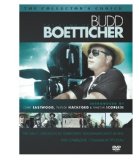
| Cast: | Randolph Scott, Karen Steele, Pernell Roberts, James Best, Lee Van Cleef, James Coburn |
| Genre: | Western |
| Director: | Budd Boetticher |
| Screenplay: | Burt Kennedy |
| Cinematography: | Charles Lawton Jr. |
| Composer: | Heinz Roemheld |
Ride Lonesome (1959) was the first of Boetticher’s “Ranown” cycle to utilize the new CinemaScope process, and it does so impressively. The rich color and expressionist framing of desert canyon rock would only be topped in the series’ final entry, Comanche Station. Most fans of the cycle consider Ride Lonesome the best entry. While that remains debatable, it is certainly, in terms of composition and pacing, the most perfectly structured. It is also the most elegiac and, surprisingly, optimistic.
Amongst a memorable cast, Lee Van Cleef etches out an unforgettable, albeit brief, performance as the murderous brother of James Best (later known as the bumbling deputy in the TV series Dukes of Hazard), who is prisoner to Randolph Scott’s bounty hunter. Naturally, things are more complex than they seem. Scott wants Cleef to catch up with them and for a very personal, startling reason: Cleef hanged Scott’s wife years before. Along the journey Scott meets up with the beautiful Karen Steele, and a pair of pseudo-outlaws in Pernell Roberts (Trapper John M.D) and a shockingly young James Coburn (his first film). Roberts and Coburn want Best for themselves, since turning him in, dead or alive, will gain them amnesty from their crimes. Naturally, there is sexual tension between Steele and Scott, yet the potential for relationship is doomed by Scott’s obsessive thirst for revenge.
Ride Lonesome is Boetticher’s most optimistic film (as optimistic as Boetticher can be and still be Boetticher). Scott’s eventual handing over of Best to the two repentant outlaws is a pleasant surprise. The villains are hardly two-dimensional. Cleef, having committed a heinous crime, earnestly begs for his brother’s life, only to fall on Scott’s deaf ears.
The four males desire and vie for the widowed Steele (her husband having been murdered by the Apaches). At first she is mere ornamentation, as the women in the Boetticher films sometimes tend to be. Later, Steele’s character somewhat evolves into mother, latent lover, comforter, but short of fully developed person. Full development of female characters and weak scoring are the two biggest flaws in the otherwise outstanding Ranown cycle.
Boetticher still finds time for adroit comic touches amidst the overwhelming ironies and the final, haunting, lyrical image of the burning tree that Scott’s wife died on. Steele leaves her protector there, in the desert, alone. He will never be happy, nor find contentment. Indeed, one is left with the ominous feeling that the ravaged Scott himself will die there, never leaving this spot. This final shot sears in the memory. To summarize: Ride Lonesome is as optimistic as Boetticher can be and still be Boetticher.
    |